
Worms Revolution
Developer: Team 17
Publisher: Team 17
Platform: PC (reviewed), XBLA, PSN
Release Date: October 10 (Europe/USA), October 11 (Australia)
Price:
Available Here
Overview
“More like Worms Evolution, amirite?” I said to no one in particular, when I first saw the game. My awful pun felt appropriate at the time: it looked to me like little more than a graphical update of the basic formula.
Sure, it was pretty, and Worms is always fun, but visuals can only carry you so far when Worms Reloaded is still fresh in the memory.
Then I heard about the worm classes. And dynamic water. And physics objects. And Matt Berry.
I still wasn’t convinced they were game-changing factors, but I was intrigued. Does Worms Revolution earn the right to call itself a revolution?
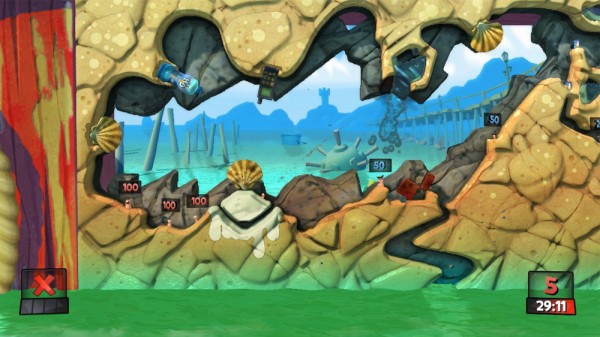
Gameplay
Basic worm warfare involves two or more teams of the dirt-dwellers battling it out across randomly-generated landscapes or ready-made landmarks, using bazookas, grenades, banana bombs, exploding sheep, gassy grumpy grannies, their own disembodied fists, and anything else they can throw or shoot at each other.
Worms Revolution keeps this structure intact, spruces it up with a shiny new engine, and attempts to revolutionize the formula with new features of varying importance.
The worms now come in four distinct flavours, varying in attack power, damage resistance, mobility and special abilities. Your standard worm is the Soldier: average in most areas, this is the type of worm you’ve been playing with in previous games.

The Heavy is a chunkier fellow, who’s as good at taking damage as he is at dishing it out. His “big bones” make moving around the landscape difficult – not good when he’s struggling to climb that slight incline, but handy when an enemy’s attack would send a lesser worm to the bottom of the ocean.
The Scout is the anti-Heavy: small in stature and nimble in nature, he’s good at getting around and finding hidey holes other worms can’t reach. He’s more susceptible to damage though, as explosions will fling him further.
Lastly, the Scientist shows brains can trump brawn. Support is his specialty, as he heals his team each turn, and puts that spectacular noggin to use increasing the strength of technical weapons, like air strikes and sentry guns.
The classes open up new strategies while aiding existing ones. The Scientist, for example, seems designed for a Darkside playstyle: hide him away in an underground lair, defended by his strengthened sentry guns, where he can heal his team each turn and use his powered-up air strikes to attack from safety.
You can build your team out of any combination of classes, unlocking additional worms for your roster with coins earned in the single-player portion of the game. In practice, the four classes aren’t drastically different, but taking advantage of the subtleties can tip the tide of battle, and dictate how you position your worms and attack enemies.
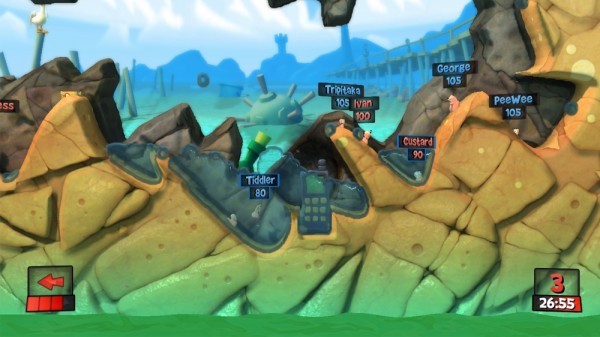
Mastering classes is a fun addition, but the real game-changer is dynamic water. It might not sound like much, but its inclusion opens up a whole host of new strategies. Water’s always been a serious hazard – it’s hard to swim without arms and legs, after all – but besides the ever-present ocean swallowing up any worm that falls into it, water can now appear
naturally on landscapes, or be called into battle from a range of new aquatic weapons.
This dynamic water reacts to the game’s physics, flowing logically while retaining an element of unpredictability. It will pool in crevices, wash hapless worms downhill, and can slowly drown them if left submerged. Blasting open a natural dam to flood a crowded area is an effective (and fun) way to deal huge damage over time, or for more immediate kills, water-based weapons can function as long-range prods, pushing worms into danger.
Less integral but no less fun are the new physics objects embedded in the terrain. Once dislodged, they will roll around, creating useful cover or annoying obstacles. Some can be broken open to unleash further havoc, in the form of water, poison gas or ‘splosions. They’re fun to play with, and several new weapons give you increased powers over them, but they still feel somewhat under-utilized.
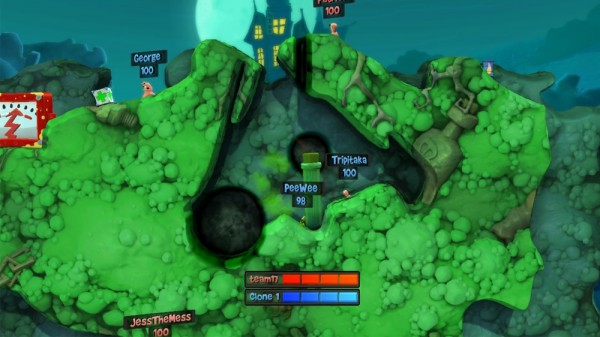
Learning the details will take some time, and the single player campaign is the best place to start, for Worms veterans and n00bs alike. The first eight missions take you through the basics of movement, combat, classes, water, etc, before throwing in some challenging battles to test you. The new Puzzle mode asks you to find creative solutions to simple problems, and requires a type of thinking not normally employed in Worms.
The single-player modes are a handy introduction to the game’s new and old elements, but playing with AI enemies doesn’t compare to human opponents. Traditionally Worms is equal parts skill and luck, but the AI messes up that balance by almost entirely removing luck from the equation. While you might spend a few turns using trial-and-error to land that grenade within damage-distance of an enemy, the AI will near-perfectly bounce it, roll it and time it to detonate next to you, on the first try, with extremely frustrating frequency.
Conversely, they won’t see the value of a weapon crate inches from their face, or the danger of rising water. Players may take a turn to collect an enticing loot drop, or high-tail it to higher ground when the rising water of sudden death mode begins to lap around their ankles. But the idiot-savant AI will resist these basic self-preservation instincts, and will likely spend the turn before they’re swallowed up by the ocean firing off another perfect shot at a distant enemy.
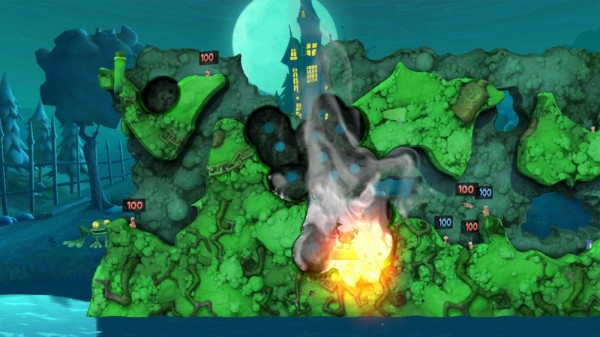
Other times, their behaviour is downright unexplainable. In one match, an AI opponent had an opportunity to devastate one of my worms, sitting between two oil drums near the sea. A well-placed stick of dynamite would have triggered a swift death, but this worm had his own master plan. He thought about it for two-thirds of his turn, before dropping next to his target, prodding him for a total of zero points of damage, then, presumably out of shame, dived into the ocean himself.
As expected, the single player modes are mere preparation for the meat of the game: playing against human opponents, who provide a great mix of skill, luck, logic and trash-talk.
One of the greatest pleasures offered by classic Worms is watching your friend’s face as you gently prod his last worm into the sea. Same-room “hot seat” multiplayer has always been a key feature, but Revolution has strangely reduced the ease and detail of playing with friends on one machine.
In every other Worms game we’ve owned, each of us in the household would have a team, and certain friends would make their own as well.
Now you can create one and only one, and the team name defaults, uneditable, to your Steam username (having reviewed the PC version, I can’t say whether this is true of the PSN/XBLA versions, but I expect it is). If friends want to join in, they have to play as clones of your team, although thankfully they can select different load-outs of worm classes.
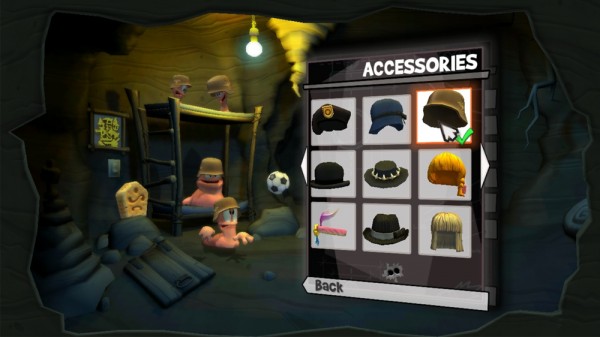
Customizing your team’s appearance is another series staple now suffering from over-simplification. Where you could once dress up your worms with multiple costume pieces, worms can now don only a single item of clothing. A hat OR glasses, not both. It’s probably not going to bother the majority of players too much, but it seems odd to backpedal on such a regular feature of the franchise.
Fortunately these issues are largely limited to the front-end: after navigating the awkward menu system and setting up a game with reduced customization and team options, it plays like a dream. The problems are easily forgiven amidst the formula’s fun, and playing multiplayer online (something I missed out on, there being no community before the game’s official launch) may alleviate them entirely.
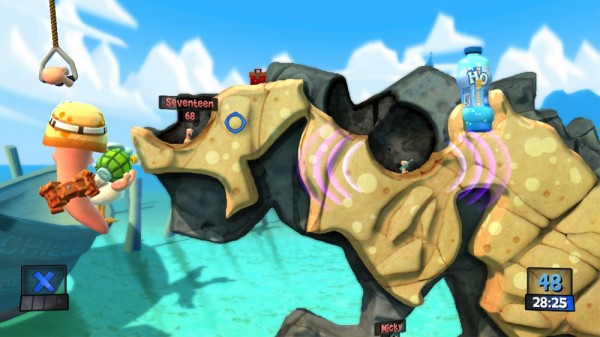
Visuals & Audio
Worms have always been very expressive, particularly in the 3D titles. Revolution blends that with the gameplay of the 2D games, creating a strong sense of personality.
As such, worms will scream when a grenade lands next to them, beg when a crosshair is aimed at them, point and laugh at enemies when they miss a shot.
The voice sets exacerbate the charm. This time they’ve been given a bit more variety, with multiple sayings for each event – a relief, given it normally begins to grate after hearing the same line every turn.
The IT Crowd’s Matt Berry is perfectly cast as Don Keystone, nature documenter and narrator of the single player modes. His cocky, smooth voice fits the ridiculous Worms aesthetic well, lending an air of undeserved authority to the proceedings. It’s a shame the script often fails to give him something interesting to say, but his smouldering vocals can wring humour from the driest of lines.
Overall
A couple of puzzling steps backward are easily countered by some large steps forward in intriguing directions. Classes, dynamic water and physics objects are creative new vessels of fun, deepening existing strategies while allowing new ones to emerge.
Dipped in a Matt Berry-flavoured aesthetic, Worms Revolution is different enough to entice fans back into the weird world of Worms, and familiar enough to remind them why they were fans in the first place.


